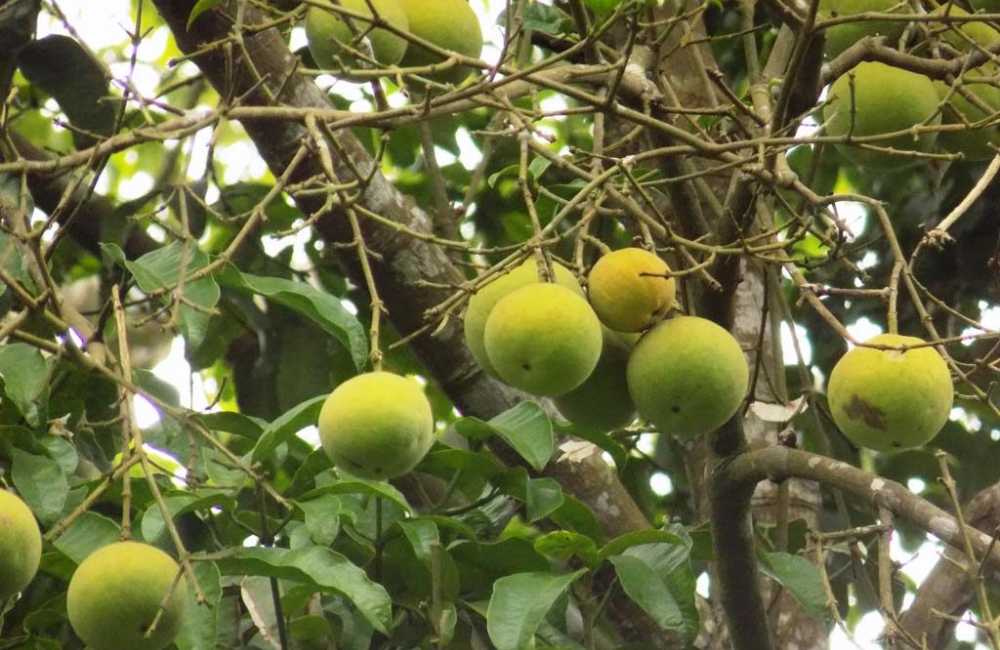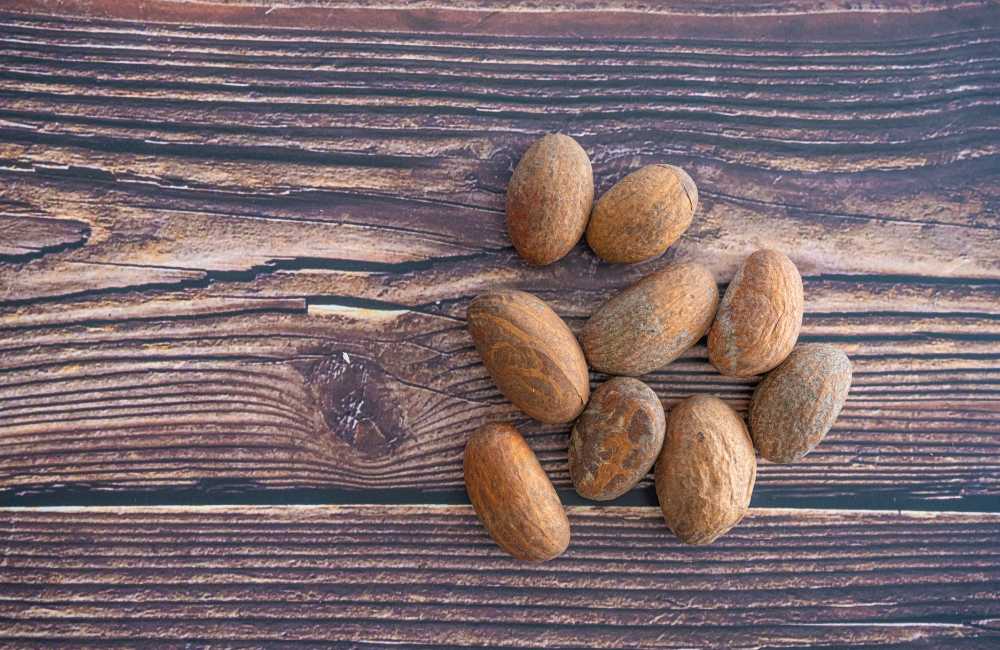Bitter kola as it is popularly known is a species of flowering plant belonging to the Mangosteen genus Garcinia of the family Clusiaceae, an evergreen tree, with a heavy spreading crown, that usually grows up to 12-15meters but can grow up to 30meters. It can be cultivated but is usually, naturally occurring in the wild.
The trunk is straight with brown bark while the leaves are leathery. The flowers are greenish-white. The tree grows mostly in the dense rain forest of tropical Africa like Sierra Leone, Ivory Coast, Cameroon, Mali, DRC, Liberia, Southern Nigeria, Zaire and Angola.
The fruit, seeds (“bitter kola nuts”) and bark of the plant have been used for centuries in folk medicine. Locally, bundles of pencil-sized wood are commonly sold as chew sticks.
You can rightly say the tree is a multipurpose tree and very important in the local economy. The seeds (kola nuts) are used and recognized more economically and medicinally than other parts of the tree.
Nutritional and Phytochemical Contents of Bitter Kola
It has been shown to contain some Flavonoids, Phenol, Alkaloids, Saponin and Tannin. Nutritionally, bitter kola showed upon analysis to contain:
- High level of carbohydrates.
- A little amount of crude fibre and protein.
- A negligible amount of ash content and crude fat.
How Does Bitter Kola Taste?
All parts are used in traditional African medicine but the seeds are mostly commonly eaten. The extremely sour fruits are sometimes eaten too. They are orange-sized and contain a yellow pulp surrounding four seeds.
The seeds have a sharp, bitter flavor that eases into a slight sweetness as you chew, and they are typically eaten raw.
Parts of Bitter Kola
Let us look at how the different parts of the plant have been used medicinally to benefit humanity in one way or the other:
-
The Wood (Stem and Root)
The sap is creamy white, the heart-wood yellow, darkening to brown at the centre, hard close-grained, finishing smoothly and taking a good polish. It is durable and fairly resistant to termites.
-
- The principal application of wood is for chew sticks. In western Africa, it is widely used as it is said to whiten the teeth and clean the mouth.
- The root is also used as chew sticks, sometimes referred to the stem wood as it is widely believed to prevent dental caries.
-
The Bark
- The bark contains an abundant sticky resinous gum which is used in treating gonorrhoea when taken orally.
- The gum is applied externally for skin infections and used to seal new wounds
- When the bark is boiled, the decoction is used to treat female sterility. The intake continues daily until conception is established and then half of the quantity is taken throughout the pregnancy.
- The extract from the bark shows aphrodisiac (substance that can enhance sexual performance or desire)activity.
- It can be used to establish milk production after birth.
- It can be used to ease childbirth and expel a dead fetus.
- A tea of the bark combined with African peach (Sarcocephaluslatifolius has a strong reputation as a diuretic, urinary decongestant, and treatment for chronic urethral discharge.
- The bark can be combined with the seed to treat stomach pains.
- The bark can be combined with the leaves to treat pulmonary and gastrointestinal troubles.
-
The Leaves
- The leaves have a bitter taste. An infusion of the leaves acts as a purgative.
-
The Fruits
- The fruits are eaten in Africa (Nigeria) to take care of headaches and general body pains.
- The fruits can equally be taken to expel worms or destroy them.
-
The Seeds (Bitter Kola Nuts)
The most esteemed part of the tree is the seed. This is commonly chewed by the rural and metropolitan populaces to prevent or treat gastric issues.
Health Benefits of Bitter Kola
It is widely used in traditional medicine in Africa, with most parts of the plant being used in treating a wide range of ailments. Some evidence shows that the bioactive components of the seeds can treat infections and other health conditions that will soon be listed below:
-
Lower Blood Sugar
Bitter kola seed has been shown to reduce and normalize blood sugar levels in diabetic persons but should be used in moderation.
Consumption of the seed significantly helps in improving complications of diabetes by decreasing the blood sugar level, enhancing the antioxidant system, and inhibiting lipid peroxidation. This therapy is best in the early phase of diabetes.
-
Fights Malaria
Chewing two or three nuts (with some water) can improve the symptoms of malaria at the early stage. The stem, bark, and seeds can be used in treating intense fever, inflammation of the respiratory tract and throat infections.
-
Immune Booster
The high antioxidant property of the bioactive compound in bitter kola not only helps in fighting microbes but increases the immunity of the body, thereby helping the body resist infection.

-
Reduce Eye Pressure
Glaucoma is a disease that damages the eye’s optic nerve. It usually happens when fluid builds up in the front part of the eye. The extra fluid increases the pressure in the eye, damaging the optic nerve. This causes a progressive loss of sight and when left untreated results in blindness.
In any case, Garcinia kola is beneficial in this condition. Taking bitter kola two times or more a day helps to ease eye pressure.
-
Lessen Osteoarthritis Pain
It has been noticed that there is an increased awareness and interest in herbal medicines worldwide. It is not strange that many that suffer from arthritis prefer to use natural herbal medicines to relieve pain as the orthodox choices usually worsen the condition on long-term use and may even predispose the users to other health conditions like degeneration of the joint and ulcers.
It has been discovered to significantly decrease inflammation and pain in osteoarthritis as a result of the bioflavonoid it contains.
-
Antitussive
Chewing the seeds is known to relieve cough, hoarseness, and bronchial and throat troubles. This works better when mixed with honey, especially for dry coughs that have defied orthodox cure.
-
Fights Dysentery
Bitter kola is taken dry as a remedy for dysentery and also its’ anti-microbial activity makes it very valuable in the management of food poisoning caused by organisms that contaminate food. It is recommended that you chew some bitter kola after eating any food you suspect may be contaminated.
Tannin is a good astringent that is active in GI disorders like dysentery and diarrhoea. The bark and seed eaten together aids in the detoxification of the human system, particularly in instances of food poisoning.
-
Anti Snake Poison
It has been known to neutralize snake poison. Ingested within minutes of snake bite stimulates urination of the toxins out of the body. This equally works with scorpion stings too.
To keep snakes away in the environment, simply grind the bitter kola and mix it up with ground maize then spread it around the compound, especially where these snakes are likely to pass.
-
Anti-Parasitic Activity
It has been found to have anti-parasitic effects against Trypanosoma brucei responsible for African trypanosomiasis and so used for sleeping sickness.
-
Antivirus
The bitter kola seed has been used traditionally to treat measles and mumps in children.
-
Antimicrobial Activity
Bitter kola contains benzophenone such as kolanone and flavanone which are responsible for its antimicrobial activity against both gram-positive and gram-negative microorganisms e.g. Bacillus, Clostridium, Salmonella, Escherichia Klebsiella, Pseudomonas, Staphylococcus etc.
Effects of Eating Excess Bitter Kola
Bitter kola is generally known as a “wonder plant” because it has so many health benefits, especially when consumed in moderate amounts. On the other hand, when consumed in excess usually causes some problems in the body, like worsening what it should normally take care of.
Let us take a look at some of these effects of excessive intake of bitter kola.
- It has been discovered through research that constant and excessive consumption of bitter kola can cause mouth cancer or gastrointestinal cancer.
- It contains a high amount of caffeine, that when eaten in excess can be quite unhealthy, especially for people with cardio problems.
- Consuming too many bitter kola seeds can lead to glaucoma but when taken in small quantity prevents glaucoma.
- Due to the high content of caffeine in bitter kola, it is not beneficial for those who suffer from diabetes when consumed in excess because it can lead to incorrect blood sugar level readings.
- When consumed in excess can worsen diarrhoea especially when one has diarrhoea already.
- Bitter kola slows blood clotting naturally so eating a large amount of the bitter kola seeds can worsen bleeding in persons who have bleeding problems. It is advised that persons booked for surgeries should avoid taking bitter kola periods before the surgery.
- If you have problems with stress and anxiety, keep away from the consumption of bitter kola. The bitter kola seeds have components that can cause an unstable psychological state in a person after consumption.
How to Avoid The Side Effects of Bitter Kola
There are advantages and disadvantages to consuming bitter kola. The effects on the body depend only on the way you consume it. The doctors advise that not more than two bitter kola seeds should be consumed per day to avoid some health issues that may result from abuse.
Conclusion
Bitter kola is very beneficial but care must be taken in its consumption so as not to consume it in excess and also not to consume it when you are on other medications to avoid interactions.

